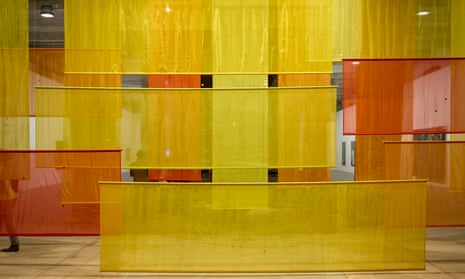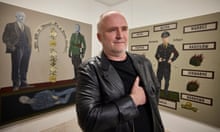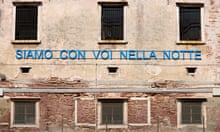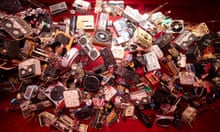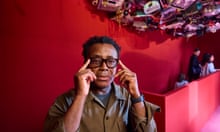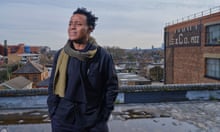Billionaires’ yachts and protests; cocktail parties and culture wars; bellinis and boycotts. The Venice Biennale’s opening preview days are always a place of odd clashes and juxtapositions, as artists, curators, critics and wealthy collectors descend on the city to take in often politically radical art.
But this year’s edition vibrates with particular uncertainty and tension – even, perhaps, an end-of-days atmosphere. The biennale, which this year stages exhibitions from 88 national pavilions, has been touched by political currents that originate far beyond the lapping waters of the Venetian lagoon.

Police equipped with riot shields are not an ordinary sight in Venice’s Giardini, one of the main venues for the biennale. But this Wednesday, they were there – as were protesters, shouting “Viva Palestina” and handing out leaflets with the text “No death in Venice”. Under the banner of Anga – short for “art not genocide alliance” – a collective of artists and creatives were calling for a boycott of the Israel pavilion, in the light of the escalating conflict in Gaza. “We demand the boycott of the Israeli pavilion. We demand the biennale shut it down,” read the leaflets. A flashmob descended not only on the Israel pavilion, but also the pavilions of the US, UK, France and Germany.
The biennale did not shut it down. And, by then, the official Israeli artist, Ruth Patir, had made the decision not to open her exhibition, leaving the national pavilion presided over by Italian military. A poster fixed to the window stated it would remain closed until “a ceasefire and hostage release agreement is reached”.
Yael Bartana, another prominent Israeli artist, who has never represented her homeland in the biennale but in 2011 represented Poland and this year has a work in the German pavilion, lamented what she saw as a narrowing gap for subtle expression in an increasingly polarised environment. “Unfortunately, at the moment there is no space for manoeuvre and ambiguity. I’m always questioning the idea of nation states, belonging, my own identity,” said the artist, who is based in Berlin and Amsterdam.
Her film for the German pavilion uses sci-fi tropes to create an end-of-days story of humanity leaving Earth – perhaps to start afresh away from the traumas created by modern nation states – in a spacecraft whose design is based on the kabbalistic tree of life. “Everyone I know wants a ceasefire and the hostages released. The artist and curators [of the Israel pavilion] have my respect for taking what must have been a very tough decision,” she said.

There is Palestinian work present at the biennale. In the main, centrally curated exhibition, organised by the Brazilian curator Adriano Pedrosa, is a delicate but large-scale sculptural textile work by Dana Awartani, made from strips of silk which she rips – representing bomb damage in Gaza – before painstakingly darning the tears. Come, Let Me Heal Your Wounds. Let Me Mend Your Broken Bones, is its title.
Healing and resilience is also a leitmotif of an official “collateral” event, South West Bank, featuring work by Palestinian artists. “Using art to heal is what we have always done,” said one of them, Dima Srouji. “Now the art can speak for itself for the first time as everyone is finally listening.” Her work, made with Jasbir Puar, an academic, is called Untitled (Onion Masks). It consists of a reproduction of a photograph from 1940 showing Australian soldiers in Gaza wearing gas masks while peeling onions, combined with delicate blown-glass sculptures. The work refers to the practice of modern Palestinian protesters of incorporating onions into improvised masks to protect them from teargas.
after newsletter promotion
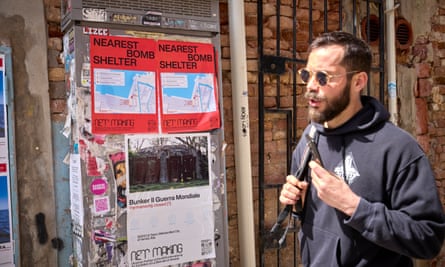
Elsewhere in the biennale, other conflicts come into focus. Ukraine’s pavilion shows, among other works, an hour-long film of shaky civilian-shot phone footage of terrifying events unfolding on Ukrainian streets, put together from thousands of clips by the artists Daniil Revkovskyi and Andrii Rachynskyi. The Ukrainian team are also responsible for the posters cropping up around the city showing maps of the nearest bomb shelter, just in case. (It turns out that Venice has one, “permanently closed” as the map declares, very near to the Ukrainian pavilion in the city’s Arsenale.)
Even when war is not the subject, themes of decolonisation, migration, and dispossession seem omnipresent, from John Akomfrah’s beautiful but unsettling epic video work for the UK pavilion, to Archie Moore’s meditation on Aboriginal erasure and colonial injustice in the Australian pavilion. These ideas chime with the title of the biennale, Stranieri Ovunque – Foreigners Everywhere, in which Pedrosa has created a central exhibition teeming with work from the global south, focusing on queer and Indigenous artists in particular.
Some see this as a culmination of sorts. In two years’ time, the next curator will have been appointed by the new president of the Venice Biennale, the provocative rightwing intellectual Pietrangelo Buttafuoco – himself nominated by Giorgia Meloni’s government. Whatever political or social change is on its way, the biennale, as ever, is likely to reflect it – or even predict it.
The Venice Biennale runs from 20 April to 24 November.
